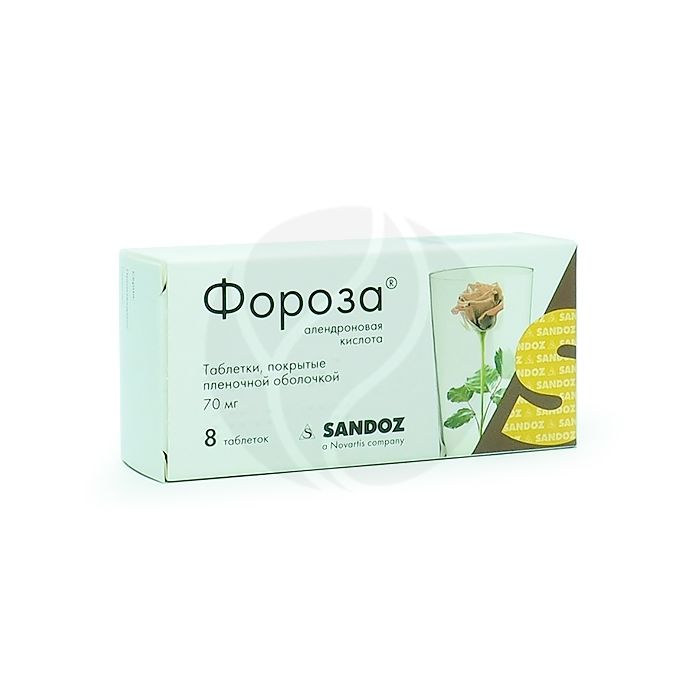Forosa tablets 70mg, No. 8
Expiration Date: 11/2025
Russian Pharmacy name:
Фороза таблетки 70мг, №8
Treatment of osteoporosis in postmenopausal women, incl. to reduce the risk of compression fractures of the spine and hip fractures;
treatment of osteoporosis in men to prevent fractures;
treatment of osteoporosis caused by prolonged use of corticosteroids.
Inside.
To ensure proper absorption of the drug, ForosaЃ tablets must be taken on an empty stomach in the morning with a glass of plain water (at least 200 ml), at least 30 minutes before the first meal, drinks or other medications. Other drinks (including mineral water) may reduce absorption of the drug.
To reduce the risk of esophageal irritation, ForosaЃ tablets should be taken:
1. Only after full awakening and getting out of bed.
2. Swallow whole (do not chew, dissolve or dissolve them in the mouth due to the possible formation of ulcers in the mouth and pharynx.
3. You should not take a horizontal position before the first meal, which should be done no earlier than 30 minutes after taking the pills.
4. Do not take the drug before bedtime or before getting out of bed in the morning.
The recommended dose is 70 mg (1 tab.) 1 time per week.
For elderly patients and patients with impaired liver function, moderate impairment of renal function (Cl creatinine> 35 ml / min), dose adjustment is not required.
In patients with severe renal impairment (Cl creatinine less than 35 ml / min), the use of the drug is not recommended, since there is no experience of use in this population.
Film-coated tablets
1 tab.
active substance:
sodium alendronate trihydrate 91.35 mg (equivalent to 70 mg alendronic acid)
excipients: MCC - 261.25 mg; anhydrous colloidal silicon dioxide - 3.5 mg; croscarmellose sodium - 1.28 mg; magnesium stearate - 2.62 mg film shell: Luster Clear LC103 (MCC - 44%; carrageenan - 18%, macrogol 8000 - 38%) - 7 mg
Hypersensitivity to alendronate or other components of the drug;
strictures or achalasia of the esophagus and other conditions leading to a slowdown in the movement of food through the esophagus;
inability of the patient to stand or sit for 30 minutes;
hypocalcemia;
severe renal failure (Cl creatinine <35 ml / min);
severe disorders of mineral metabolism;
pregnancy;
lactation period;
children's age (efficacy and safety of use have not been established).
With caution: patients with gastrointestinal diseases such as dysphagia, gastritis, duodenitis, peptic ulcer in the acute stage, active gastrointestinal bleeding or surgery in the upper gastrointestinal tract in history, hypovitaminosis D.
pharmachologic effect
Bone resorption inhibitor. Aminobisphosphonate is an analogue of pyrophosphate. The mechanism of action is associated with the suppression of osteoclast activity. Stimulates osteogenesis, restores a positive balance between bone resorption and restoration, progressively increases bone mineral density (regulates calcium-phosphorus metabolism), promotes the formation of bone tissue with a normal histological structure.
Pharmacokinetics
Taking alendronic acid immediately before, during or after a meal leads to a decrease in bioavailability. When taken with coffee or orange juice, the bioavailability of alendronate sodium is reduced by approximately 60%.
After oral administration in therapeutic doses, the concentration of alendronate in blood plasma is usually below the lowest concentration that can be determined (less than 5 ng / ml).
It is temporarily distributed in soft tissues, then quickly redistributed into the bones or excreted in the urine. Plasma protein binding is approximately 78%. Not metabolized. It is excreted mainly by the kidneys. T1 / 2 in the final phase can be more than 10 years, which is associated with the release of the active substance from the bones.
Side effect
From the digestive system: pain in the epigastric region; rarely - constipation, diarrhea, flatulence, dysphagia.
From the side of metabolism: asymptomatic hypocalcemia.
Dermatological reactions: skin rash, erythema.
Others: headache, myalgia.
Application during pregnancy and lactation
Adequate and strictly controlled clinical studies of the safety of the use of alendronic acid during pregnancy and lactation have not been conducted. If necessary, use during lactation, breastfeeding should be discontinued.
In experimental studies on rats, it was shown that alendronic acid at doses of 2 mg / kg / day and higher causes discoordination of labor due to hypocalcemia; at doses more than 5 mg / kg / day, a decrease in fetal weight was noted.
Application for impaired renal function
Not recommended for severe renal impairment.
Application in children
Not recommended for use in children.
special instructions
It is not recommended for use in severely impaired renal function, as well as in children.
Use with caution in diseases of the gastrointestinal tract in the acute phase.
Before starting treatment, patients with mineral metabolism disorders should be fully corrected.
The interval between taking alendronic acid and other drugs should be at least 1 hour.
Drug interactions
When taken orally with other drugs and products containing calcium, the absorption of alendronic acid is impaired.
In postmenopausal women who received estrogens, there were no side effects associated with the use of alendronic acid.
In clinical studies, an increase in the frequency of adverse reactions from the digestive system was observed when using alendronic acid at a dose of more than 10 mg / day during therapy with acetylsalicylic acid.

